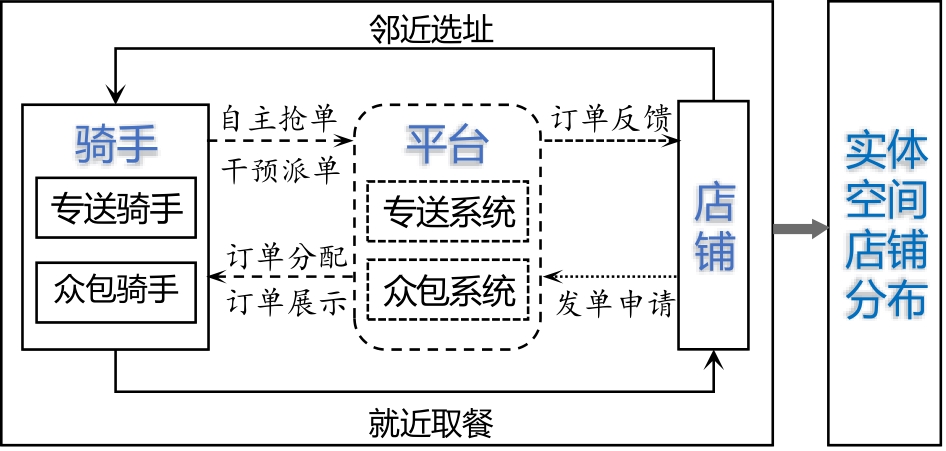

Virtual-Real Space Mediation: A Study on the Formation Mechanism of a Takeaway Factory Based on the Delivery Rider's Perspective
Received date: 2024-04-12
Revised date: 2024-06-02
Online published: 2024-08-09
In the digital economy era, take-out shops relying on the online-to-offline e-commerce platform have gathered in central cities on a large scale, forming large-scale food processing spaces—"Takeaway Factories"— to serve immediate local catering needs. In addition to the impact of the platform economy, consumer demand, and space costs, riders are an important and dynamic factor that promote the final formation of a "Takeaway Factory". Based on the analysis framework of virtual and real-space interactions using the participatory survey method, the specific roles of crowdsourcing and special delivery riders in the formation of "Takeaway Factory" was elucidated. Riders, as the core intermediaries of virtual agglomeration that leads to physical agglomeration, play a role at different stages and spatial scales. In the initial stage, because dedicated takeout shops tend to prefer low-cost, high-demand urban gap spaces, they face challenges in matching with special delivery riders until they are included in the special delivery distribution station. Thus, crowdsourcing riders with free-movement attributes are their first choice. Crowdsourcing riders have a strong preference for store clusters and select food through the two tools of the regional order heat map and grab order hall, bringing about differences in distribution efficiency and promoting the phenomenon of large regional differentiation of relatively concentrated and dispersed stores within the city scale. In the middle stage, in the face of the uneven distribution efficiency of different areas in the city, the platform divides the size of the stations according to the size of the shops in different areas, and matches the special delivery riders of the corresponding scale, which eliminates the uneven distribution efficiency of different areas to a certain extent, and promotes the distribution efficiency of different sections to reach a basic balance. With the emergence of special delivery systems, the special delivery riders are distributed in the station area through the delivery system, which effectively alleviates the distribution pressure of the relatively dispersed, inferior-location stores and promotes the balance of the distribution efficiency of different sections. In the final stage, the special delivery and crowdsourcing riders in the area jointly promote the agglomeration of shops in the area, and ultimately promote the formation of a more polarized takeaway factory. Crowdsourcing riders continue to promote agglomeration from the initial stage, whereas the emergence of special delivery riders promotes both equilibrium and agglomeration. With the increasing maturity of the special delivery and crowdsourcing system, the time-space behavior of different types of riders will eventually promote the completion of the high-density and large-scale agglomeration of takeaway shops in the area (distribution site) through virtual tools, such as site order thermal maps, order dispatching systems, resident points, and order-grabbing halls.

Key words: mobile internet; virtual-real space; takeaway factory; rider; agglomeration; mediation; Guangzhou
Yihan Zhao , Zhendong Luo , Ji Zhang . Virtual-Real Space Mediation: A Study on the Formation Mechanism of a Takeaway Factory Based on the Delivery Rider's Perspective[J]. Tropical Geography, 2024 , 44(8) : 1423 -1434 . DOI: 10.13284/j.cnki.rddl.20240239
“我们众包跑单比专送自由多了,他们都是系统派一单一跑,还不能拒单,不咋灵活。我们有自己的办法,看热力图、抢单、拒单。你看在这图上比较红的地方,单都很多,但是这个图上也就显示了个大概,所以你就先在这一大片红的地方里选一个地方等单。刚开始得“交学费”,不管什么单你都试试看,跑一段时间你就知道这一大片地方里哪个点单多了,以后你就专门在那个地方等单,刷着抢单大厅,盯着店名和地址,抢那种店都挨在一起的单,把系统派的比较远的店的单都拒掉。”
“开店选地方和骑手也有关系,比如像石牌这种地方,因为外卖店比较多,周边全都是骑手,有时候你出餐的速度还赶不上骑手来取餐的速度,配送快了我们这儿不积压,顾客也高兴,容易给我们好评,我们也就容易提排名。你开店如果选一个周边没人做外卖的地方肯定就死了,你的餐做得再好,没有骑手来送,都是白做,根本做不起来。”
“石牌这边店这么多,根本不缺骑手,而且基本上都是众包,所以我们开店注册的时候配送服务那项选众包其实就够了。或者专送和众包都选,但是优先给众包。如果你开店开在比较偏的地方,那就得进专送站点让专送配送,不然就没人了。”
图8 专送APP中的站点订单热力图Fig.8 Heat map of distribution station orders in the Professional rider APP |

1 骑手群体分为专送和众包2种类型。专送骑手负责接收特定区域(专送配送站)内的店铺订单,接受系统派单和配送站长的管理,站长可以干预派单。众包骑手负责接收任意区域的店铺订单,并在系统展示的多个订单中自主抢单,无站长干预订单分配。因为工作模式的差异,促使2类骑手在“外卖工厂”集聚的不同时间阶段、空间尺度中发挥着作用,所以加以区分。
2 单量分布和店铺分布并非完全等同,但两者之间有着非常密切的关系。通过笔者在参与式调查中的实地踏勘体验和与骑手的多次深度访谈,发现店铺集聚区往往就是订单集聚区,两者之间有着高度的重叠,并不存在订单较多、店铺较少或订单较少、店铺较多的区域,所以将两者近似等同。
赵奕涵:论文撰写、数据收集与处理、分析框架构建与图表绘制;
罗震东:研究方法和分析框架构建指导、论文审阅与修改;
张 佶:研究思路与方法指导、论文审阅。
|
陈龙. 2020a. “数字控制”下的劳动秩序——外卖骑手的劳动控制研究. 社会学研究,35(6):113-135,244.
Chen Long. 2020a. Labor Order under Digital Control:A Study on the Labor Control of Take-Out Platform Riders. Sociological Studies, 35(6): 113-135, 244.
|
|
陈龙. 2020b. 游戏、权力分配与技术:平台企业管理策略研究——以某外卖平台的骑手管理为例. 中国人力资源开发,37(4):113-124.
Chen Long. 2020b. Games, Redistribution of Control Power and Technology: Research on Management Strategy of Platform Company: Taking the Management of One Take-Away Platform in Beijing as an Example. Human Resources Development of China, 37(4): 113-124.
|
|
陈龙,孙萍. 2021. 超级流动、加速循环与离“心”运动——关于互联网平台“流动为生”劳动的反思. 中国青年研究,(4):29-37.
Chen Long and Sun Ping. 2021. Super Flow, Accelerated Circulation and Centrifugal Movement: Reflections on the Flow of the Internet Platform for Labor. China Youth Study, (4): 29-37.
|
|
陈龙. 2022. 两个世界与双重身份——数字经济时代的平台劳动过程与劳动关系. 社会学研究,37(6):81-100,228.
Chen Long. 2022. Two Worlds and Dual Identities: Platform Labor Process and Labor Relation in the Era of Digital Economy. Sociological Research, 37(6): 81-100, 228.
|
|
邓智平. 2021. “接单游戏”与平台经济中的劳动实践——以外卖骑手为例. 求索,(3):108-117.
Deng Zhiping. 2021. Labor Practices in Take-Up Games and the Platform Economy: The Example of Take-Out Riders. Seeker, (3): 108-117.
|
|
冯向楠,詹婧. 2019. 人工智能时代互联网平台劳动过程研究——以平台外卖骑手为例. 社会发展研究,6(3):61-83,243.
Feng Xiang'nan and Zhan Jing. 2019. Research on Labor Process in Platform Economy in the Age of AI: Taking the Takeaway Riders as an Example. Journal of Social Development, 6(3): 61-83, 243.
|
|
高文珺. 2021. 新就业形态下外卖骑手社会流动特点和影响因素. 山东社会科学,(5):100-108.
Gao Wenjun. 2021. Social Mobility Characteristics and Influencing Factors of Takeaway Riders Under New Employment Patterns. Shandong Social Sciences, (5): 100-108.
|
|
胡放之. 2019. 网约工劳动权益保障问题研究——基于湖北外卖骑手的调查. 湖北社会科学,(10):56-62.
Hu Fangzhi. 2019. Research on the Protection of Labor Rights and Interests of Online Contract Workers: Based on the Investigation of Hubei Takeout Riders. Hubei Social Sciences,(10): 56-62.
|
|
李胜蓝,江立华. 2020. 新型劳动时间控制与虚假自由——外卖骑手的劳动过程研究. 社会学研究,35(6):91-112,243-244.
Li Shenglan and Jiang Lihua. 2020. A New Mode of Labor Time Control and Fake Experience of Freedom: A Study on the Labor Process of Take-Out Platform Riders. Sociological Research, 35(6): 91-112, 243-244.
|
|
李怡然. 2022. 困住骑手的是系统吗?——论互联网外卖平台灵活用工保障制度的完善. 中国劳动关系学院学报,36(1):67-79.
Li Yiran. 2022. Is the System Trapping the Rider?—On Improving the Flexible Employment Guarantee System for Internet Food Delivery Platforms. Journal of China University of Labor Relations, 36 (1): 67-79.
|
|
罗震东,毛茗,张佶,廖顺意,方鹏飞. 2022. 移动互联网时代城市新空间形成机制——以“外卖工厂”为例. 城市规划学刊,(04):64-70.
Luo Zhendong, Mao Ming, Zhang Ji, Liao Shunyi, and Fang Pengfei. 2022. Takeaway Factory: Formation Mechanism of New Urban Spaces in the Mobile Internet Era. Urban Planning Forum, (4): 64-70.
|
|
莫惠斌,罗珂,王少剑,周春山. 2022. 广州市中心城区餐饮店空间分异与机制差异研究——基于传统店与外卖店的对比. 地理研究,41(12):3318-3334.
Mo Huibin, Luo Ke, Wang Shaojian, and Zhou Chunshan. 2022. Spatial Heterogenicity and Mechanism Difference of Restaurant in the Central Urban Area of Guangzhou: A Comparison between Traditional Restaurant and Take-Out Restaurant. Geographical Research, 41(12): 3318-3334.
|
|
施响,王士君,浩飞龙,周双双. 2019. 基于实体店比较的长春市外卖O2O餐饮业空间特征及成因. 人文地理,34(2):80-89.
Shi Xiang, Wang Shijun, Hao Feilong, and Zhou Shuangshuang. 2019. The Spatial Distribution and Formation of Takeaway O2O Catering Industry Based on Entity Restaurants Comparison in Changchun. Human Geography, 34(2): 80-89.
|
|
束开荣. 2022a. 构建数字劳动的物质网络:平台规训、算法协商与技术盗猎——基于“送外卖”的田野调查. 新闻与传播研究,29(9):39-58,126-127.
Shu Kairong. 2022a. Constructing the Material Network of Digital Labor: Platform Discipline, Algorithm Negotiation, and Technology Poaching a Field Investigation of Food Delivery. Journalism & Communication, 29(9): 39-58, 126-127.
|
|
束开荣. 2022b. 流动的媒介化生存:平台劳动中的移动交互界面——基于“送外卖”的田野调查. 新闻记者,(2):58-70.
Shu Kairong. 2022b. Mediated Survival of Mobility: Mobile Interactive Interfaces in Platform Labor—Fieldwork Based on Food Delivery. Shanghai Journalism Review, (2): 58-70.
|
|
汤玉箫,吴祖泉,陈宏胜. 2022. 互联网时代苏州餐饮业空间特征及影响因素. 热带地理,42(11):1904-1917.
Tang Yuxiao, Wu Zuquan, and Chen Hongsheng. 2022. Spatial Characteristics and Influencing Factors of Suzhou's Catering Industry in the Internet Era. Tropical Geography, 42 (11): 1904-1917.
|
|
田志鹏. 2022. 不稳定就业与新职业群体市民化研究:以骑手为例. 中国社会科学院大学学报,42(11):90-103,135.
Tian Zhipeng. 2022. Precarious Employment and the Citizenization of New Occupational Groups: A Study Based on Takeaway Riders. Journal of University of Chinese Academy of Social Sciences, 42(11): 90-103, 135.
|
|
王宇凡,林文盛,冯长春. 2019. 信息技术对城市生活服务业空间分布的影响——以北京网络外卖餐饮业为例. 城市发展研究,26(6):100-107.
Wang Yufan, Lin Wensheng, and Feng Changchun. 2019. The Impacts of Information and Communication Technologies(ICT) on the Spatial Distribution of Urban Customer Services: A Case Study of Online Takeaway Industry in Beijing. Urban Development Studies, 26(6): 100-107.
|
|
邢海燕,黄爱玲. 2017. 上海外卖“骑手”个体化进程的民族志研究. 中国青年研究,(12):73-79.
Xing Haiyan and Huang Ailing. 2017. An Ethnographic Study on the Individualization Process of Shanghai Takeout Riders. China Youth Study, (12): 73-79
|
|
杨滨伊. 2021. 保障外卖骑手劳动权益的双重路径. 社会治理,(10):63-66.
Yang Binyi. 2021. Dual Path to Protect the Labor Rights and Interests of Takeaway Riders. Social Governance Review, (10): 63-66.
|
|
晏龙旭. 2017. “均质化-再集聚”:互联网影响下餐饮业空间布局新特征——基于上海内环开放数据的研究. 城市规划学刊,(4):113-119.
Yan Longxu. 2017. The Impact of Online Take-out Service on Restaurant Location Characteristics—A Study Based on Open Data in Shanghai Inner City. Urban Planning Forum, (4): 113-119.
|
|
杨子江,何雄,张堃,张军. 2020. POI视角下的外卖与城市空间关联性分析研究——以昆明主城区为例. 城市发展研究,27(2):13-17.
Yang Zijiang, He Xiong, Zhang Kun, and Zhang Jun. 2020. Analysis of the Correlation Between Takeaway and Urban Space from the Perspective of POI: A Case Study of Main Area in Kunming. Urban Development Studies, 27(2): 13-17.
|
|
中国信息通信研究院. 中国数字经济发展报告(2022年). (2022-07-08)[2024-03-20]. http://www.caict.ac.cn/kxyj/qwfb/bps/202207/t20220708_405627.htm.
China Academy of Information and Communications Technology. China Digital Economy Development Report(2022). (2022-07-08) [2024-03-20]. http://www.caict.ac.cn/kxyj/qwfb/bps/202207/t20220708_405627.htm.
|
|
张梦雨,王强,朱杰. 2022. 福州市外卖O2O与传统餐饮业空间分布特征及影响因素对比. 地理科学,42(8):1463-1473.
Zhang Mengyu, Wang Qiang, and Zhu Jie. 2022. Comparison of the Spatial Distribution and Influencing Factors of O2O Takeaway and Traditional Catering Industry in Fuzhou, China. Scientia Geographica Sinica, 42(8): 1463-1473.
|
|
智研咨询. 2022. 中国外卖行业全景速览:外卖行业迅猛发展,2021年我国外卖订单量超200亿单. (2022-09-30)[2024-03-20]https://www.chyxx.com/industry/1126163.html.
Zhiyan Consulting. 2022. Overview of China's Take-Out Industry: The Rapid Development of the Take-Out Industry, in 2021 China's Take-Out Orders More than 20 Billion Orders. (2022-09-30) [2024-03-20]. https://www.chyxx.com/industry/1126163.html.
|
|
钟雨妮,罗震东,方鹏飞. 2023. 移动互联网时代社区商业空间的演化——基于杭州市主城区的实证. 城市规划,47(8):12-20.
Zhong Yuni, Luo Zhendong, and Fang Pengfei. 2023. Evolution of Neighborhood Commercial Space in the Mobile Internet Era: A Case Study of Hangzhou Main Urban Area. City Planning Review, 47(8): 12-20.
|
/
| 〈 |
|
〉 |